
The peppered moth is a temperate species of night-flying moth. It is mostly found in the northern hemisphere in places like Asia, Europe and North America. Peppered moth evolution is an example of population genetics and natural selection.

The geometer moths are moths belonging to the family Geometridae of the insect order Lepidoptera, the moths and butterflies. Their scientific name derives from the Ancient Greek geo γεω, and metron μέτρον "measure" in reference to the way their larvae, or inchworms, appear to measure the earth as they move along in a looping fashion. A very large family, it has around 23,000 species of moths described, and over 1400 species from six subfamilies indigenous to North America alone. A well-known member is the peppered moth, Biston betularia, which has been subject of numerous studies in population genetics. Several other geometer moths are notorious pests.

The de Havilland Gipsy Major or Gipsy IIIA is a four-cylinder, air-cooled, inverted inline engine used in a variety of light aircraft produced in the 1930s, including the famous Tiger Moth biplane. Many Gipsy Major engines still power vintage aircraft types.

Saturnia pavonia, the small emperor moth, is a moth of the family Saturniidae. It was first described by Carl Linnaeus in his 1758 10th edition of Systema Naturae. Sometimes, the incorrect genus name Pavonia is still used for this species. This moth occurs throughout the Palearctic region and is the only member of its family to be found in the British Isles, where it is usually called simply the emperor moth.

Vigna aconitifolia is a drought-resistant legume, commonly grown in arid and semi-arid regions of India. It is commonly called mat bean, moth bean, matki or dew bean. The pods, sprouts and protein-rich seeds of this crop are commonly consumed in India. Moth bean can be grown on many soil types, and can also act as a pasture legume.

Gracillariidae is an important family of insects in the order Lepidoptera and the principal family of leaf miners that includes several economic, horticultural or recently invasive pest species such as the horse-chestnut leaf miner, Cameraria ohridella.
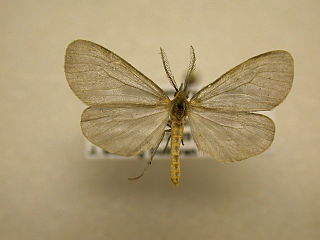
Pagara is a monotypic moth genus in the family Erebidae. Its only species, Pagara simplex, the mouse-colored lichen moth, is found in North America, where it has been recorded from Alabama, Arkansas, Florida, Georgia, Illinois, Indiana, Iowa, Kansas, Kentucky, Maryland, Mississippi, New Hampshire, North Carolina, Ohio, Oklahoma, South Carolina and Tennessee. Both the genus and species were described by Francis Walker in 1856.

Cyclophora ruficiliaria, the Jersey mocha, is a moth of the family Geometridae. The species was first described by Gottlieb August Wilhelm Herrich-Schäffer in 1855. It can be found in Europe, in particular the Channel Islands as well as other parts of the mainland United Kingdom.
Geshna is a monotypic moth genus of the family Crambidae described by Harrison Gray Dyar Jr. in 1906. It contains only one species, Geshna cannalis, the lesser canna leafroller, described by Altus Lacy Quaintance in 1898. It is found in North America, where it has been recorded from Florida, Mississippi, South Carolina, North Carolina and Tennessee. It has also been recorded from Costa Rica and Cuba.
Paracorsia is a monotypic moth genus of the family Crambidae described by H. Marion in 1959. It contains only one species, Paracorsia repandalis, described by Michael Denis and Ignaz Schiffermüller in 1775. It is found in most of Europe, except Ireland, Fennoscandia and the Baltic region. It has also been recorded from central Asia, including Iran and Kyrgyzstan and North America where it has been recorded in southern Ontario and northern Indiana.

Abantiades latipennis, known as the Pindi moth, is a species of moth in the family Hepialidae. It may also be referred to as a swift moth or a ghost moth, as this is a common name associated with Hepialidae. Endemic to Australia and identified in 1932, it is most populous in temperate rainforest where eucalypti are prevalent, as the larvae feed primarily on the roots of these trees. Females lay eggs during flight in a scattering fashion. The larvae live for over eighteen months underground, while adult moths survive for approximately one week, as they have no mouthparts with which to feed. The moths are preyed upon by a number of predators, including bats and owls. Brown in colour overall, males are paler and the identifying silver bars of the male's wings are more prominent than those of the female's, with dark margins. Male adults are generally smaller.

Platyptilia isodactylus is a moth of the family Pterophoridae found in China, Europe and was introduced to Australia and New Zealand for biological control. It was first described by the German entomologists, Philipp Christoph Zeller in 1852.

Pleuroprucha insulsaria, the common tan wave moth, is a moth of the family Geometridae. The species was first described by Achille Guenée in 1857. It is found in eastern North America, from Nova Scotia to Florida, west to Texas and Colorado and north to Ontario. It ranges south through Mexico and Central America into South America and has been recorded as far south as the Galápagos Islands. It has also been recorded from the West Indies, including Jamaica.

Cydalima perspectalis or the box tree moth is a species of moth of the family Crambidae, first described by Francis Walker, the English entomologist, in 1859. Native to Japan, China, Taiwan, Korea, far-east Russia and India, it has invaded Europe; first recorded in Germany in 2006, then Switzerland and the Netherlands in 2007, Great Britain in 2008, France and Austria in 2009, Hungary in 2011, then Romania, Spain and Turkey. It has been seen in Slovakia, Belgium and Croatia.
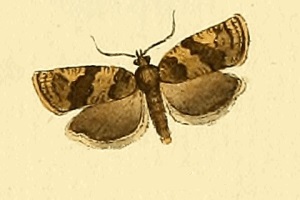
Choristoneura diversana is a species of moth of the family Tortricidae. It is found in Great Britain, France, Belgium, the Netherlands, Germany, Denmark, Austria, Switzerland, Italy, the Czech Republic, Slovakia, Slovenia, Poland, Bulgaria, Hungary, Romania, Norway, Sweden, Finland, the Baltic region, Russia and the Near East. In the east, the range extends to China (Heilongjiang), Korea and Japan. The habitat consists of gardens, scrub and fens.
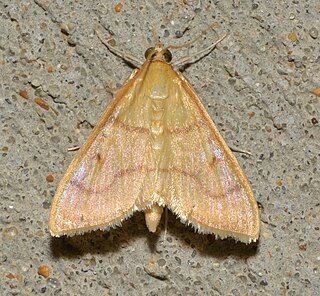
Neohelvibotys neohelvialis is a moth in the family Crambidae. It was described by Hahn William Capps in 1967. It is found in the United States, where it has been recorded from Georgia and Florida to Arizona, as well as in the West Indies and from Mexico to Panama.
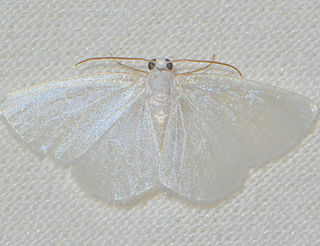
Lomographa vestaliata, the white spring moth, is a moth in the family Geometridae. The species was first described by Achille Guenée in 1857. It is found in North America, where it has been recorded from Newfoundland west to south-eastern British Columbia and south to Florida and Texas. The habitat consists of xeric shrubby edges and woodlands.

Cydosia nobilitella, the curve-lined cydosia moth or regal cydosia moth, is a moth of the family Noctuidae. The species was first described by Pieter Cramer in 1779. It is found from southern Florida south to Argentina. It is also found on the Antilles.
Nites betulella, the black-dotted birch leaftier moth, is a moth in the family Depressariidae. It was described by August Busck in 1902. It is found in North America, where it has been recorded from Nova Scotia, southern Canada, the north-eastern United States, British Columbia and Wisconsin.
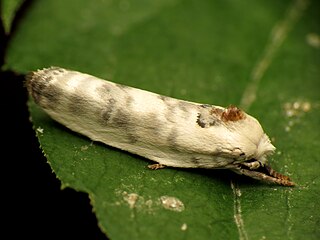
Antaeotricha leucillana, the pale gray bird-dropping moth, is a moth in the family Depressariidae. It was described by Philipp Christoph Zeller in 1854. It is found in North America, where it has been recorded from New Hampshire, Massachusetts, New York, Pennsylvania, District of Columbia, Virginia, North Carolina, Georgia, Alabama, Arkansas, Missouri, Kansas, Illinois, Iowa, Texas, Oregon, Louisiana, Manitoba and Nova Scotia.
















